Le Corbusier's Villa Savoye, Esprit Nouveau, and La Roche
VerifiedAdded on 2022/12/29
|10
|2532
|43
Essay
AI Summary
This essay critically examines the architectural innovations of Le Corbusier, a pivotal figure in modern architecture. It focuses on three of his seminal projects: Villa Savoye, Pavilion de l’Esprit Nouveau, and Villa La Roche. The analysis delves into Le Corbusier's pioneering techniques, including the use of pilotis, concrete slabs, horizontal windows, and rooftop gardens, which revolutionized building design. The essay explores how these elements contribute to the unique architectural organization and aesthetic appeal of each structure. It also discusses the influence of his designs, such as the 'Five Points' of architecture, and their lasting impact on contemporary building practices. Furthermore, the essay highlights the functional and aesthetic aspects of his work, emphasizing the integration of nature and the creation of open, flexible spaces. Through a detailed examination of these key projects, the essay provides a comprehensive understanding of Le Corbusier's contribution to the evolution of modern architecture.
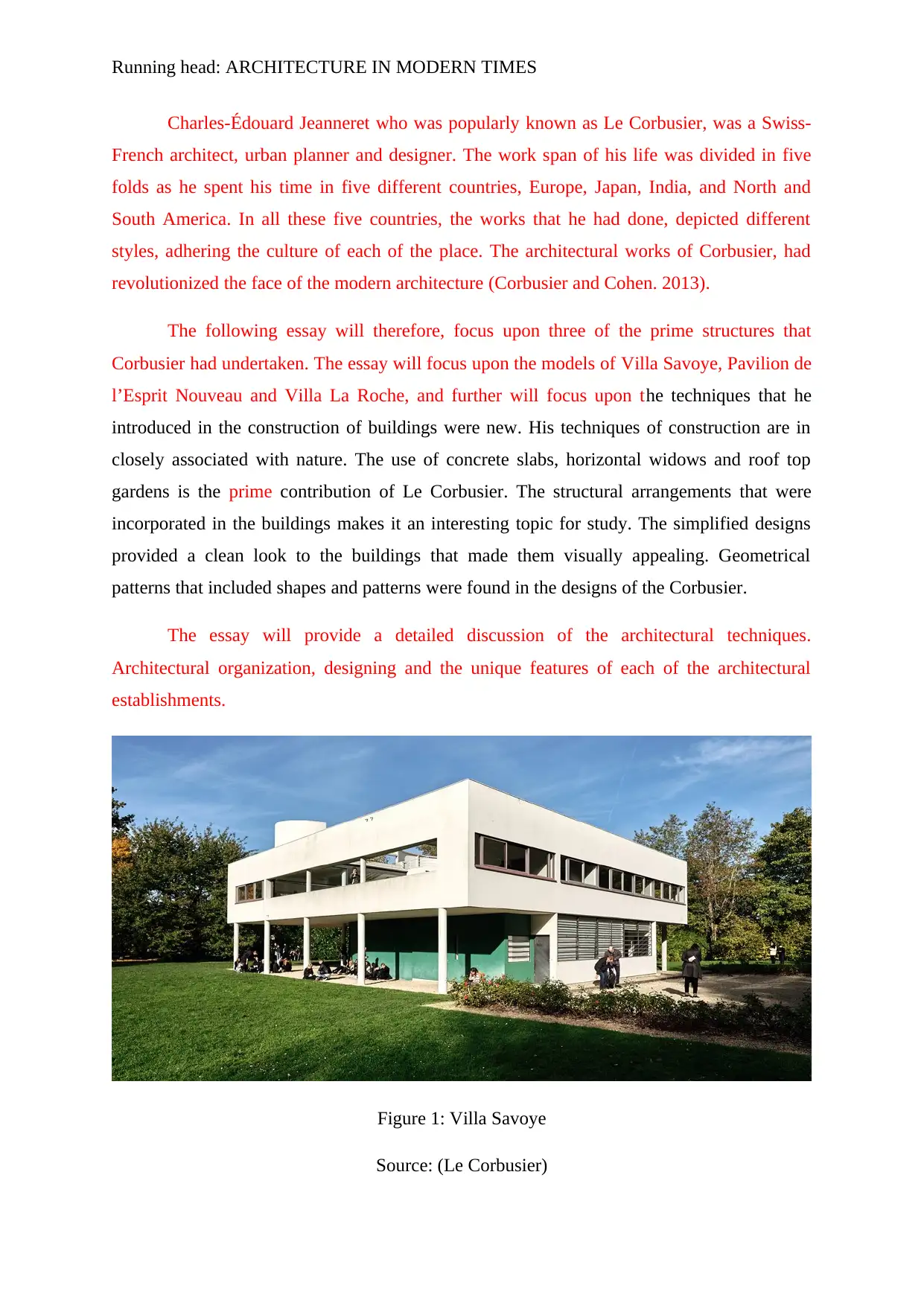
Running head: ARCHITECTURE IN MODERN TIMES
Charles-Édouard Jeanneret who was popularly known as Le Corbusier, was a Swiss-
French architect, urban planner and designer. The work span of his life was divided in five
folds as he spent his time in five different countries, Europe, Japan, India, and North and
South America. In all these five countries, the works that he had done, depicted different
styles, adhering the culture of each of the place. The architectural works of Corbusier, had
revolutionized the face of the modern architecture (Corbusier and Cohen. 2013).
The following essay will therefore, focus upon three of the prime structures that
Corbusier had undertaken. The essay will focus upon the models of Villa Savoye, Pavilion de
l’Esprit Nouveau and Villa La Roche, and further will focus upon the techniques that he
introduced in the construction of buildings were new. His techniques of construction are in
closely associated with nature. The use of concrete slabs, horizontal widows and roof top
gardens is the prime contribution of Le Corbusier. The structural arrangements that were
incorporated in the buildings makes it an interesting topic for study. The simplified designs
provided a clean look to the buildings that made them visually appealing. Geometrical
patterns that included shapes and patterns were found in the designs of the Corbusier.
The essay will provide a detailed discussion of the architectural techniques.
Architectural organization, designing and the unique features of each of the architectural
establishments.
Figure 1: Villa Savoye
Source: (Le Corbusier)
Charles-Édouard Jeanneret who was popularly known as Le Corbusier, was a Swiss-
French architect, urban planner and designer. The work span of his life was divided in five
folds as he spent his time in five different countries, Europe, Japan, India, and North and
South America. In all these five countries, the works that he had done, depicted different
styles, adhering the culture of each of the place. The architectural works of Corbusier, had
revolutionized the face of the modern architecture (Corbusier and Cohen. 2013).
The following essay will therefore, focus upon three of the prime structures that
Corbusier had undertaken. The essay will focus upon the models of Villa Savoye, Pavilion de
l’Esprit Nouveau and Villa La Roche, and further will focus upon the techniques that he
introduced in the construction of buildings were new. His techniques of construction are in
closely associated with nature. The use of concrete slabs, horizontal widows and roof top
gardens is the prime contribution of Le Corbusier. The structural arrangements that were
incorporated in the buildings makes it an interesting topic for study. The simplified designs
provided a clean look to the buildings that made them visually appealing. Geometrical
patterns that included shapes and patterns were found in the designs of the Corbusier.
The essay will provide a detailed discussion of the architectural techniques.
Architectural organization, designing and the unique features of each of the architectural
establishments.
Figure 1: Villa Savoye
Source: (Le Corbusier)
Paraphrase This Document
Need a fresh take? Get an instant paraphrase of this document with our AI Paraphraser
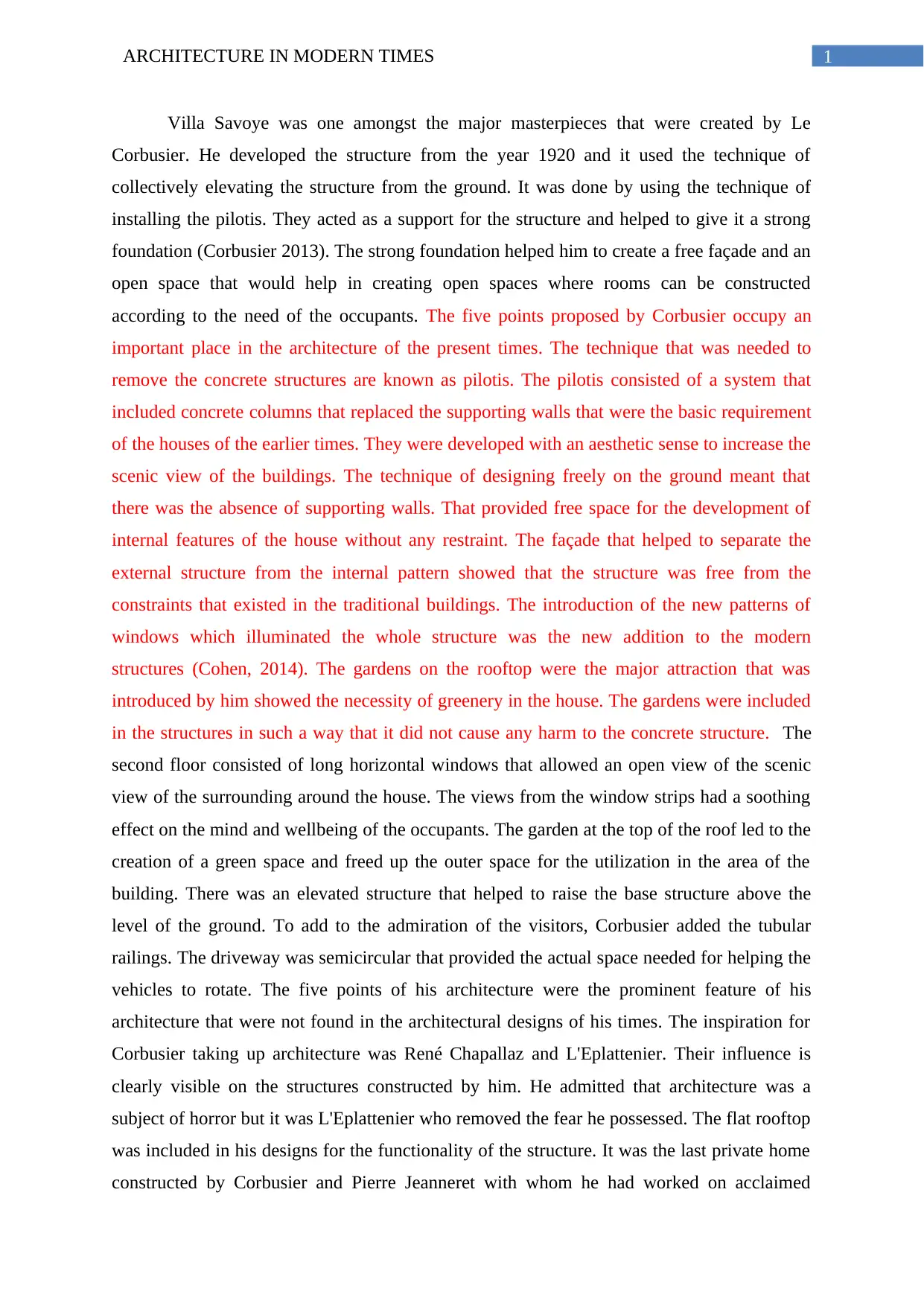
1ARCHITECTURE IN MODERN TIMES
Villa Savoye was one amongst the major masterpieces that were created by Le
Corbusier. He developed the structure from the year 1920 and it used the technique of
collectively elevating the structure from the ground. It was done by using the technique of
installing the pilotis. They acted as a support for the structure and helped to give it a strong
foundation (Corbusier 2013). The strong foundation helped him to create a free façade and an
open space that would help in creating open spaces where rooms can be constructed
according to the need of the occupants. The five points proposed by Corbusier occupy an
important place in the architecture of the present times. The technique that was needed to
remove the concrete structures are known as pilotis. The pilotis consisted of a system that
included concrete columns that replaced the supporting walls that were the basic requirement
of the houses of the earlier times. They were developed with an aesthetic sense to increase the
scenic view of the buildings. The technique of designing freely on the ground meant that
there was the absence of supporting walls. That provided free space for the development of
internal features of the house without any restraint. The façade that helped to separate the
external structure from the internal pattern showed that the structure was free from the
constraints that existed in the traditional buildings. The introduction of the new patterns of
windows which illuminated the whole structure was the new addition to the modern
structures (Cohen, 2014). The gardens on the rooftop were the major attraction that was
introduced by him showed the necessity of greenery in the house. The gardens were included
in the structures in such a way that it did not cause any harm to the concrete structure. The
second floor consisted of long horizontal windows that allowed an open view of the scenic
view of the surrounding around the house. The views from the window strips had a soothing
effect on the mind and wellbeing of the occupants. The garden at the top of the roof led to the
creation of a green space and freed up the outer space for the utilization in the area of the
building. There was an elevated structure that helped to raise the base structure above the
level of the ground. To add to the admiration of the visitors, Corbusier added the tubular
railings. The driveway was semicircular that provided the actual space needed for helping the
vehicles to rotate. The five points of his architecture were the prominent feature of his
architecture that were not found in the architectural designs of his times. The inspiration for
Corbusier taking up architecture was René Chapallaz and L'Eplattenier. Their influence is
clearly visible on the structures constructed by him. He admitted that architecture was a
subject of horror but it was L'Eplattenier who removed the fear he possessed. The flat rooftop
was included in his designs for the functionality of the structure. It was the last private home
constructed by Corbusier and Pierre Jeanneret with whom he had worked on acclaimed
Villa Savoye was one amongst the major masterpieces that were created by Le
Corbusier. He developed the structure from the year 1920 and it used the technique of
collectively elevating the structure from the ground. It was done by using the technique of
installing the pilotis. They acted as a support for the structure and helped to give it a strong
foundation (Corbusier 2013). The strong foundation helped him to create a free façade and an
open space that would help in creating open spaces where rooms can be constructed
according to the need of the occupants. The five points proposed by Corbusier occupy an
important place in the architecture of the present times. The technique that was needed to
remove the concrete structures are known as pilotis. The pilotis consisted of a system that
included concrete columns that replaced the supporting walls that were the basic requirement
of the houses of the earlier times. They were developed with an aesthetic sense to increase the
scenic view of the buildings. The technique of designing freely on the ground meant that
there was the absence of supporting walls. That provided free space for the development of
internal features of the house without any restraint. The façade that helped to separate the
external structure from the internal pattern showed that the structure was free from the
constraints that existed in the traditional buildings. The introduction of the new patterns of
windows which illuminated the whole structure was the new addition to the modern
structures (Cohen, 2014). The gardens on the rooftop were the major attraction that was
introduced by him showed the necessity of greenery in the house. The gardens were included
in the structures in such a way that it did not cause any harm to the concrete structure. The
second floor consisted of long horizontal windows that allowed an open view of the scenic
view of the surrounding around the house. The views from the window strips had a soothing
effect on the mind and wellbeing of the occupants. The garden at the top of the roof led to the
creation of a green space and freed up the outer space for the utilization in the area of the
building. There was an elevated structure that helped to raise the base structure above the
level of the ground. To add to the admiration of the visitors, Corbusier added the tubular
railings. The driveway was semicircular that provided the actual space needed for helping the
vehicles to rotate. The five points of his architecture were the prominent feature of his
architecture that were not found in the architectural designs of his times. The inspiration for
Corbusier taking up architecture was René Chapallaz and L'Eplattenier. Their influence is
clearly visible on the structures constructed by him. He admitted that architecture was a
subject of horror but it was L'Eplattenier who removed the fear he possessed. The flat rooftop
was included in his designs for the functionality of the structure. It was the last private home
constructed by Corbusier and Pierre Jeanneret with whom he had worked on acclaimed
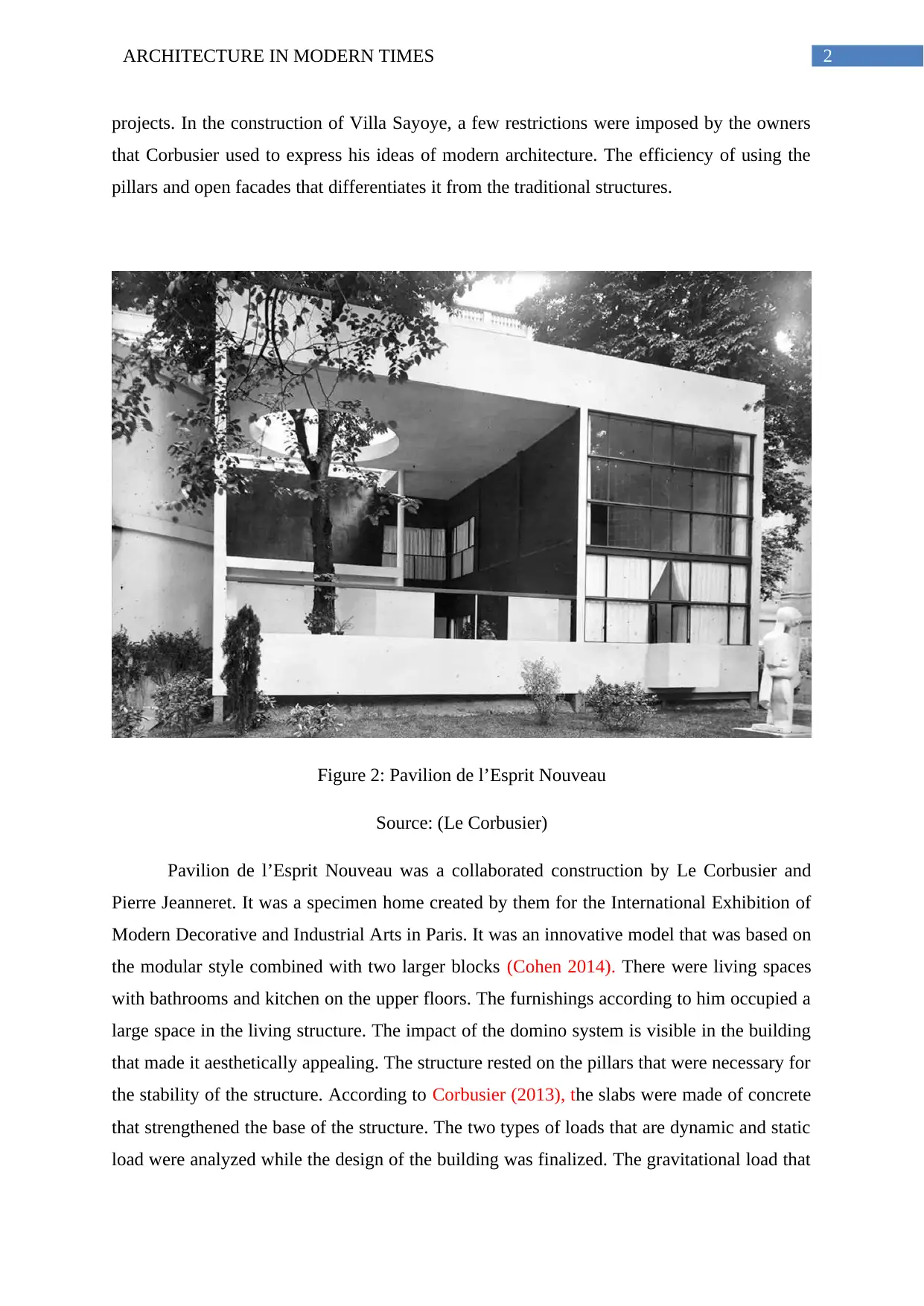
2ARCHITECTURE IN MODERN TIMES
projects. In the construction of Villa Sayoye, a few restrictions were imposed by the owners
that Corbusier used to express his ideas of modern architecture. The efficiency of using the
pillars and open facades that differentiates it from the traditional structures.
Figure 2: Pavilion de l’Esprit Nouveau
Source: (Le Corbusier)
Pavilion de l’Esprit Nouveau was a collaborated construction by Le Corbusier and
Pierre Jeanneret. It was a specimen home created by them for the International Exhibition of
Modern Decorative and Industrial Arts in Paris. It was an innovative model that was based on
the modular style combined with two larger blocks (Cohen 2014). There were living spaces
with bathrooms and kitchen on the upper floors. The furnishings according to him occupied a
large space in the living structure. The impact of the domino system is visible in the building
that made it aesthetically appealing. The structure rested on the pillars that were necessary for
the stability of the structure. According to Corbusier (2013), the slabs were made of concrete
that strengthened the base of the structure. The two types of loads that are dynamic and static
load were analyzed while the design of the building was finalized. The gravitational load that
projects. In the construction of Villa Sayoye, a few restrictions were imposed by the owners
that Corbusier used to express his ideas of modern architecture. The efficiency of using the
pillars and open facades that differentiates it from the traditional structures.
Figure 2: Pavilion de l’Esprit Nouveau
Source: (Le Corbusier)
Pavilion de l’Esprit Nouveau was a collaborated construction by Le Corbusier and
Pierre Jeanneret. It was a specimen home created by them for the International Exhibition of
Modern Decorative and Industrial Arts in Paris. It was an innovative model that was based on
the modular style combined with two larger blocks (Cohen 2014). There were living spaces
with bathrooms and kitchen on the upper floors. The furnishings according to him occupied a
large space in the living structure. The impact of the domino system is visible in the building
that made it aesthetically appealing. The structure rested on the pillars that were necessary for
the stability of the structure. According to Corbusier (2013), the slabs were made of concrete
that strengthened the base of the structure. The two types of loads that are dynamic and static
load were analyzed while the design of the building was finalized. The gravitational load that
⊘ This is a preview!⊘
Do you want full access?
Subscribe today to unlock all pages.

Trusted by 1+ million students worldwide
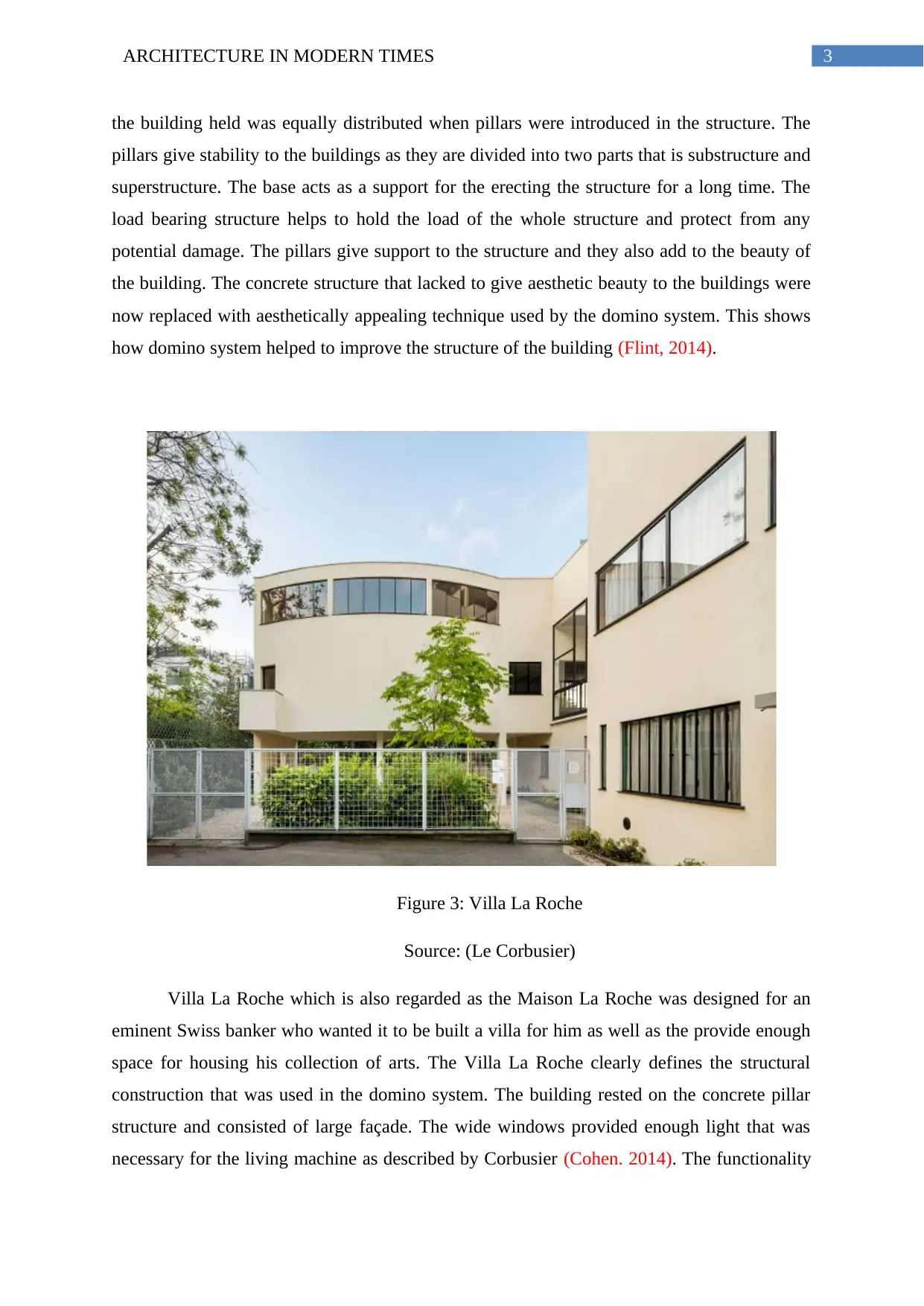
3ARCHITECTURE IN MODERN TIMES
the building held was equally distributed when pillars were introduced in the structure. The
pillars give stability to the buildings as they are divided into two parts that is substructure and
superstructure. The base acts as a support for the erecting the structure for a long time. The
load bearing structure helps to hold the load of the whole structure and protect from any
potential damage. The pillars give support to the structure and they also add to the beauty of
the building. The concrete structure that lacked to give aesthetic beauty to the buildings were
now replaced with aesthetically appealing technique used by the domino system. This shows
how domino system helped to improve the structure of the building (Flint, 2014).
Figure 3: Villa La Roche
Source: (Le Corbusier)
Villa La Roche which is also regarded as the Maison La Roche was designed for an
eminent Swiss banker who wanted it to be built a villa for him as well as the provide enough
space for housing his collection of arts. The Villa La Roche clearly defines the structural
construction that was used in the domino system. The building rested on the concrete pillar
structure and consisted of large façade. The wide windows provided enough light that was
necessary for the living machine as described by Corbusier (Cohen. 2014). The functionality
the building held was equally distributed when pillars were introduced in the structure. The
pillars give stability to the buildings as they are divided into two parts that is substructure and
superstructure. The base acts as a support for the erecting the structure for a long time. The
load bearing structure helps to hold the load of the whole structure and protect from any
potential damage. The pillars give support to the structure and they also add to the beauty of
the building. The concrete structure that lacked to give aesthetic beauty to the buildings were
now replaced with aesthetically appealing technique used by the domino system. This shows
how domino system helped to improve the structure of the building (Flint, 2014).
Figure 3: Villa La Roche
Source: (Le Corbusier)
Villa La Roche which is also regarded as the Maison La Roche was designed for an
eminent Swiss banker who wanted it to be built a villa for him as well as the provide enough
space for housing his collection of arts. The Villa La Roche clearly defines the structural
construction that was used in the domino system. The building rested on the concrete pillar
structure and consisted of large façade. The wide windows provided enough light that was
necessary for the living machine as described by Corbusier (Cohen. 2014). The functionality
Paraphrase This Document
Need a fresh take? Get an instant paraphrase of this document with our AI Paraphraser
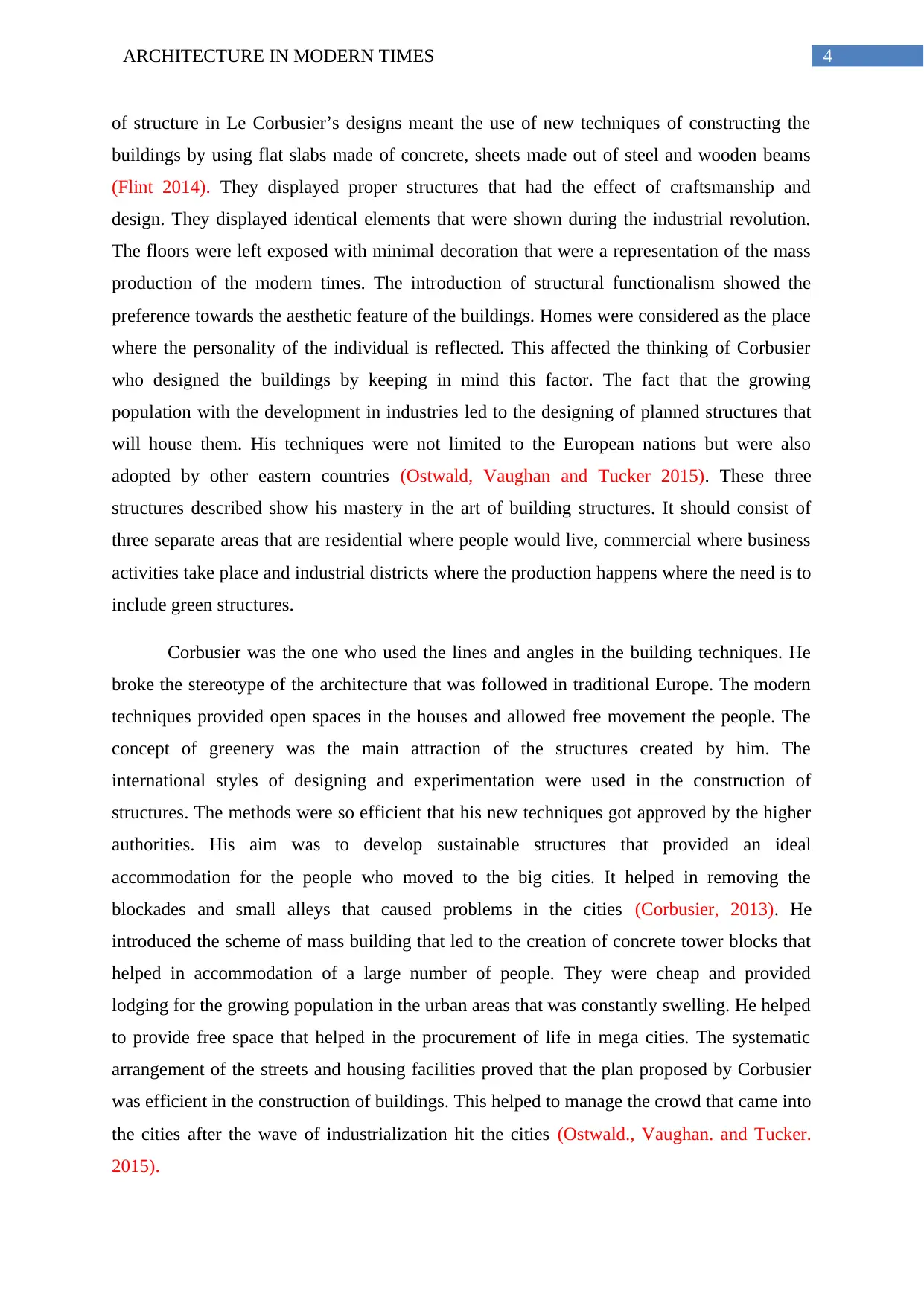
4ARCHITECTURE IN MODERN TIMES
of structure in Le Corbusier’s designs meant the use of new techniques of constructing the
buildings by using flat slabs made of concrete, sheets made out of steel and wooden beams
(Flint 2014). They displayed proper structures that had the effect of craftsmanship and
design. They displayed identical elements that were shown during the industrial revolution.
The floors were left exposed with minimal decoration that were a representation of the mass
production of the modern times. The introduction of structural functionalism showed the
preference towards the aesthetic feature of the buildings. Homes were considered as the place
where the personality of the individual is reflected. This affected the thinking of Corbusier
who designed the buildings by keeping in mind this factor. The fact that the growing
population with the development in industries led to the designing of planned structures that
will house them. His techniques were not limited to the European nations but were also
adopted by other eastern countries (Ostwald, Vaughan and Tucker 2015). These three
structures described show his mastery in the art of building structures. It should consist of
three separate areas that are residential where people would live, commercial where business
activities take place and industrial districts where the production happens where the need is to
include green structures.
Corbusier was the one who used the lines and angles in the building techniques. He
broke the stereotype of the architecture that was followed in traditional Europe. The modern
techniques provided open spaces in the houses and allowed free movement the people. The
concept of greenery was the main attraction of the structures created by him. The
international styles of designing and experimentation were used in the construction of
structures. The methods were so efficient that his new techniques got approved by the higher
authorities. His aim was to develop sustainable structures that provided an ideal
accommodation for the people who moved to the big cities. It helped in removing the
blockades and small alleys that caused problems in the cities (Corbusier, 2013). He
introduced the scheme of mass building that led to the creation of concrete tower blocks that
helped in accommodation of a large number of people. They were cheap and provided
lodging for the growing population in the urban areas that was constantly swelling. He helped
to provide free space that helped in the procurement of life in mega cities. The systematic
arrangement of the streets and housing facilities proved that the plan proposed by Corbusier
was efficient in the construction of buildings. This helped to manage the crowd that came into
the cities after the wave of industrialization hit the cities (Ostwald., Vaughan. and Tucker.
2015).
of structure in Le Corbusier’s designs meant the use of new techniques of constructing the
buildings by using flat slabs made of concrete, sheets made out of steel and wooden beams
(Flint 2014). They displayed proper structures that had the effect of craftsmanship and
design. They displayed identical elements that were shown during the industrial revolution.
The floors were left exposed with minimal decoration that were a representation of the mass
production of the modern times. The introduction of structural functionalism showed the
preference towards the aesthetic feature of the buildings. Homes were considered as the place
where the personality of the individual is reflected. This affected the thinking of Corbusier
who designed the buildings by keeping in mind this factor. The fact that the growing
population with the development in industries led to the designing of planned structures that
will house them. His techniques were not limited to the European nations but were also
adopted by other eastern countries (Ostwald, Vaughan and Tucker 2015). These three
structures described show his mastery in the art of building structures. It should consist of
three separate areas that are residential where people would live, commercial where business
activities take place and industrial districts where the production happens where the need is to
include green structures.
Corbusier was the one who used the lines and angles in the building techniques. He
broke the stereotype of the architecture that was followed in traditional Europe. The modern
techniques provided open spaces in the houses and allowed free movement the people. The
concept of greenery was the main attraction of the structures created by him. The
international styles of designing and experimentation were used in the construction of
structures. The methods were so efficient that his new techniques got approved by the higher
authorities. His aim was to develop sustainable structures that provided an ideal
accommodation for the people who moved to the big cities. It helped in removing the
blockades and small alleys that caused problems in the cities (Corbusier, 2013). He
introduced the scheme of mass building that led to the creation of concrete tower blocks that
helped in accommodation of a large number of people. They were cheap and provided
lodging for the growing population in the urban areas that was constantly swelling. He helped
to provide free space that helped in the procurement of life in mega cities. The systematic
arrangement of the streets and housing facilities proved that the plan proposed by Corbusier
was efficient in the construction of buildings. This helped to manage the crowd that came into
the cities after the wave of industrialization hit the cities (Ostwald., Vaughan. and Tucker.
2015).
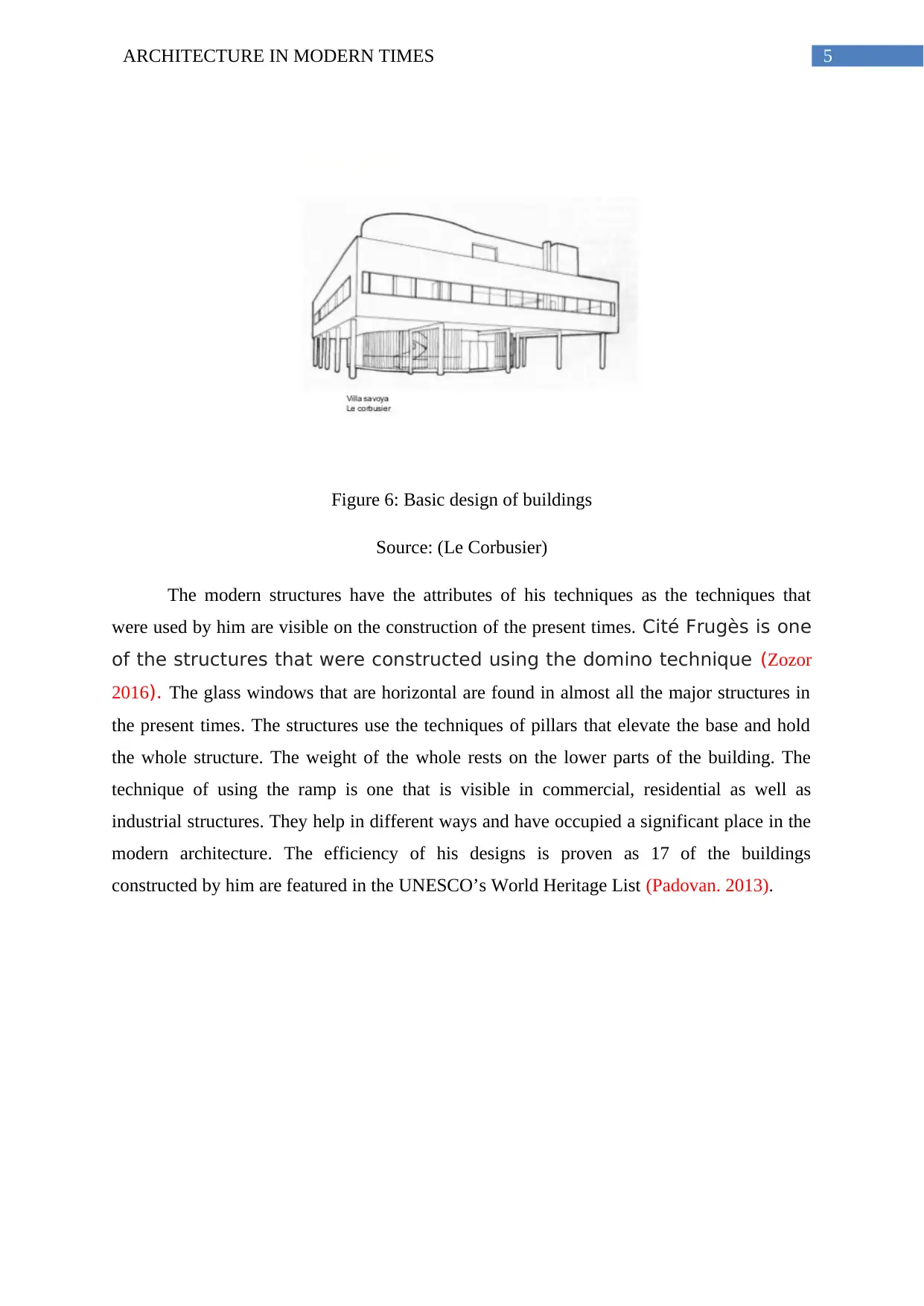
5ARCHITECTURE IN MODERN TIMES
Figure 6: Basic design of buildings
Source: (Le Corbusier)
The modern structures have the attributes of his techniques as the techniques that
were used by him are visible on the construction of the present times. Cité Frugès is one
of the structures that were constructed using the domino technique (Zozor
2016). The glass windows that are horizontal are found in almost all the major structures in
the present times. The structures use the techniques of pillars that elevate the base and hold
the whole structure. The weight of the whole rests on the lower parts of the building. The
technique of using the ramp is one that is visible in commercial, residential as well as
industrial structures. They help in different ways and have occupied a significant place in the
modern architecture. The efficiency of his designs is proven as 17 of the buildings
constructed by him are featured in the UNESCO’s World Heritage List (Padovan. 2013).
Figure 6: Basic design of buildings
Source: (Le Corbusier)
The modern structures have the attributes of his techniques as the techniques that
were used by him are visible on the construction of the present times. Cité Frugès is one
of the structures that were constructed using the domino technique (Zozor
2016). The glass windows that are horizontal are found in almost all the major structures in
the present times. The structures use the techniques of pillars that elevate the base and hold
the whole structure. The weight of the whole rests on the lower parts of the building. The
technique of using the ramp is one that is visible in commercial, residential as well as
industrial structures. They help in different ways and have occupied a significant place in the
modern architecture. The efficiency of his designs is proven as 17 of the buildings
constructed by him are featured in the UNESCO’s World Heritage List (Padovan. 2013).
⊘ This is a preview!⊘
Do you want full access?
Subscribe today to unlock all pages.

Trusted by 1+ million students worldwide
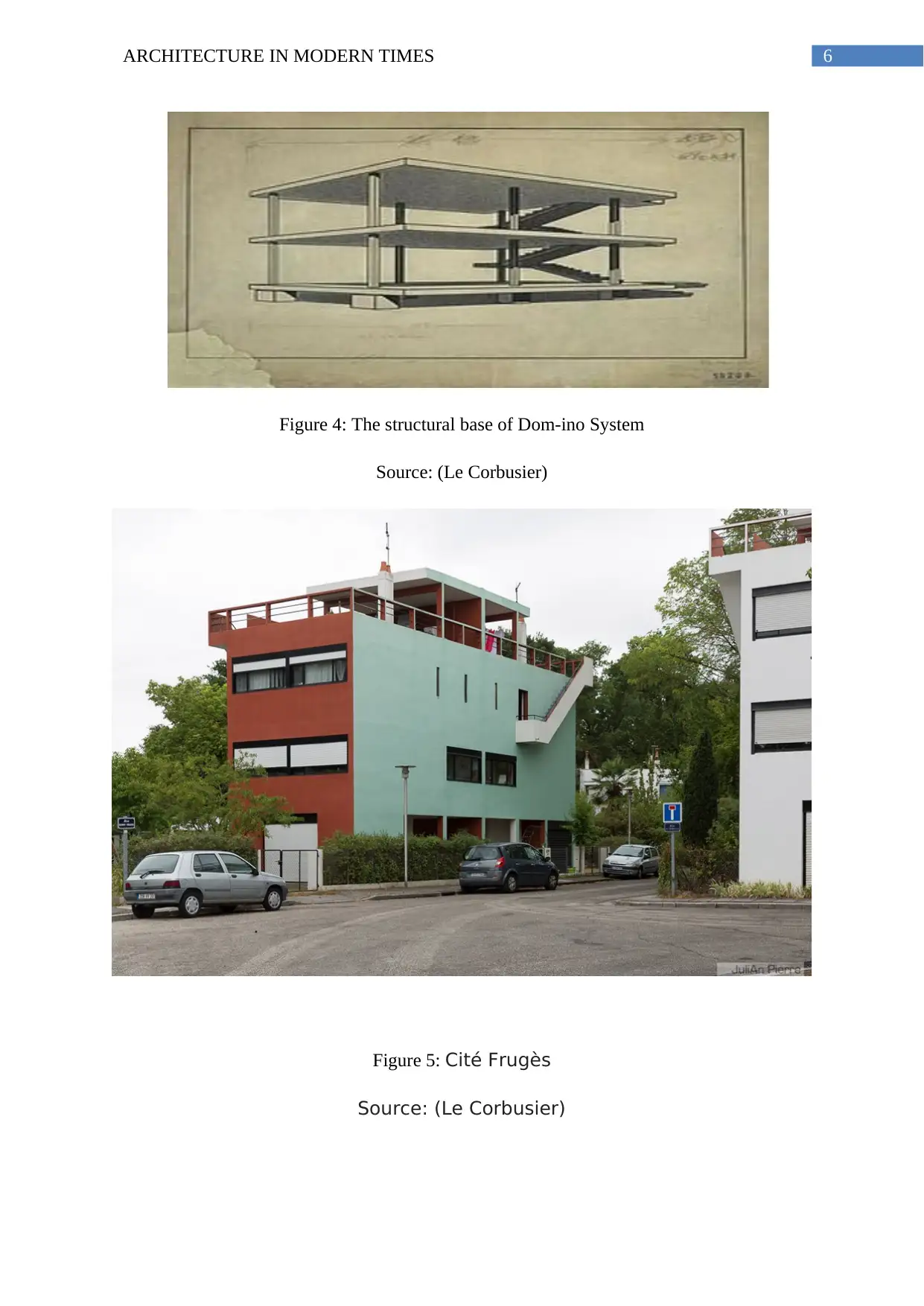
6ARCHITECTURE IN MODERN TIMES
Figure 4: The structural base of Dom-ino System
Source: (Le Corbusier)
Figure 5: Cité Frugès
Source: (Le Corbusier)
Figure 4: The structural base of Dom-ino System
Source: (Le Corbusier)
Figure 5: Cité Frugès
Source: (Le Corbusier)
Paraphrase This Document
Need a fresh take? Get an instant paraphrase of this document with our AI Paraphraser
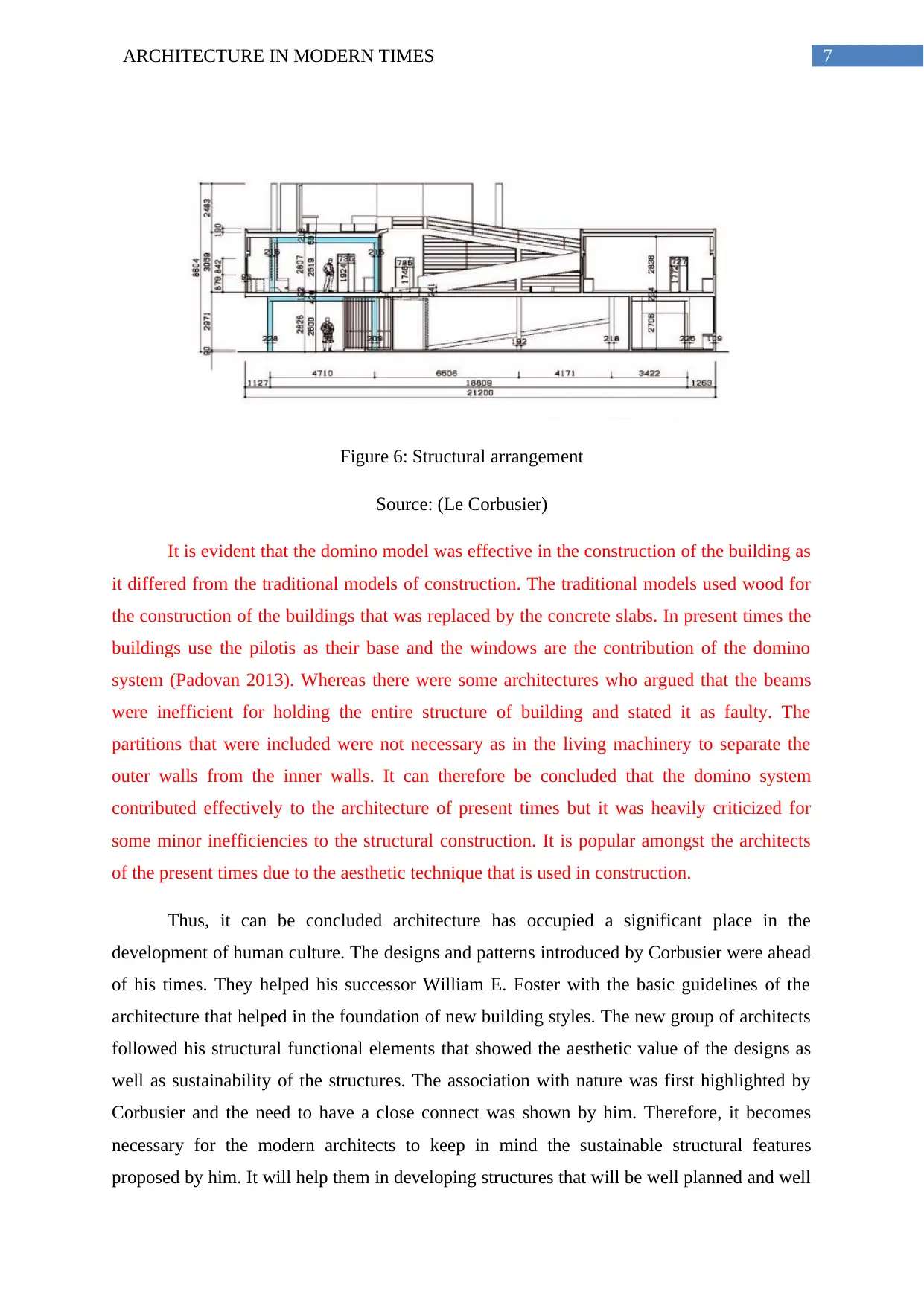
7ARCHITECTURE IN MODERN TIMES
Figure 6: Structural arrangement
Source: (Le Corbusier)
It is evident that the domino model was effective in the construction of the building as
it differed from the traditional models of construction. The traditional models used wood for
the construction of the buildings that was replaced by the concrete slabs. In present times the
buildings use the pilotis as their base and the windows are the contribution of the domino
system (Padovan 2013). Whereas there were some architectures who argued that the beams
were inefficient for holding the entire structure of building and stated it as faulty. The
partitions that were included were not necessary as in the living machinery to separate the
outer walls from the inner walls. It can therefore be concluded that the domino system
contributed effectively to the architecture of present times but it was heavily criticized for
some minor inefficiencies to the structural construction. It is popular amongst the architects
of the present times due to the aesthetic technique that is used in construction.
Thus, it can be concluded architecture has occupied a significant place in the
development of human culture. The designs and patterns introduced by Corbusier were ahead
of his times. They helped his successor William E. Foster with the basic guidelines of the
architecture that helped in the foundation of new building styles. The new group of architects
followed his structural functional elements that showed the aesthetic value of the designs as
well as sustainability of the structures. The association with nature was first highlighted by
Corbusier and the need to have a close connect was shown by him. Therefore, it becomes
necessary for the modern architects to keep in mind the sustainable structural features
proposed by him. It will help them in developing structures that will be well planned and well
Figure 6: Structural arrangement
Source: (Le Corbusier)
It is evident that the domino model was effective in the construction of the building as
it differed from the traditional models of construction. The traditional models used wood for
the construction of the buildings that was replaced by the concrete slabs. In present times the
buildings use the pilotis as their base and the windows are the contribution of the domino
system (Padovan 2013). Whereas there were some architectures who argued that the beams
were inefficient for holding the entire structure of building and stated it as faulty. The
partitions that were included were not necessary as in the living machinery to separate the
outer walls from the inner walls. It can therefore be concluded that the domino system
contributed effectively to the architecture of present times but it was heavily criticized for
some minor inefficiencies to the structural construction. It is popular amongst the architects
of the present times due to the aesthetic technique that is used in construction.
Thus, it can be concluded architecture has occupied a significant place in the
development of human culture. The designs and patterns introduced by Corbusier were ahead
of his times. They helped his successor William E. Foster with the basic guidelines of the
architecture that helped in the foundation of new building styles. The new group of architects
followed his structural functional elements that showed the aesthetic value of the designs as
well as sustainability of the structures. The association with nature was first highlighted by
Corbusier and the need to have a close connect was shown by him. Therefore, it becomes
necessary for the modern architects to keep in mind the sustainable structural features
proposed by him. It will help them in developing structures that will be well planned and well

8ARCHITECTURE IN MODERN TIMES
executed. Those structures will help in managing the crowded areas and help in creating a
chaos free cities helping in the movement of traffic and the people.
executed. Those structures will help in managing the crowded areas and help in creating a
chaos free cities helping in the movement of traffic and the people.
⊘ This is a preview!⊘
Do you want full access?
Subscribe today to unlock all pages.

Trusted by 1+ million students worldwide
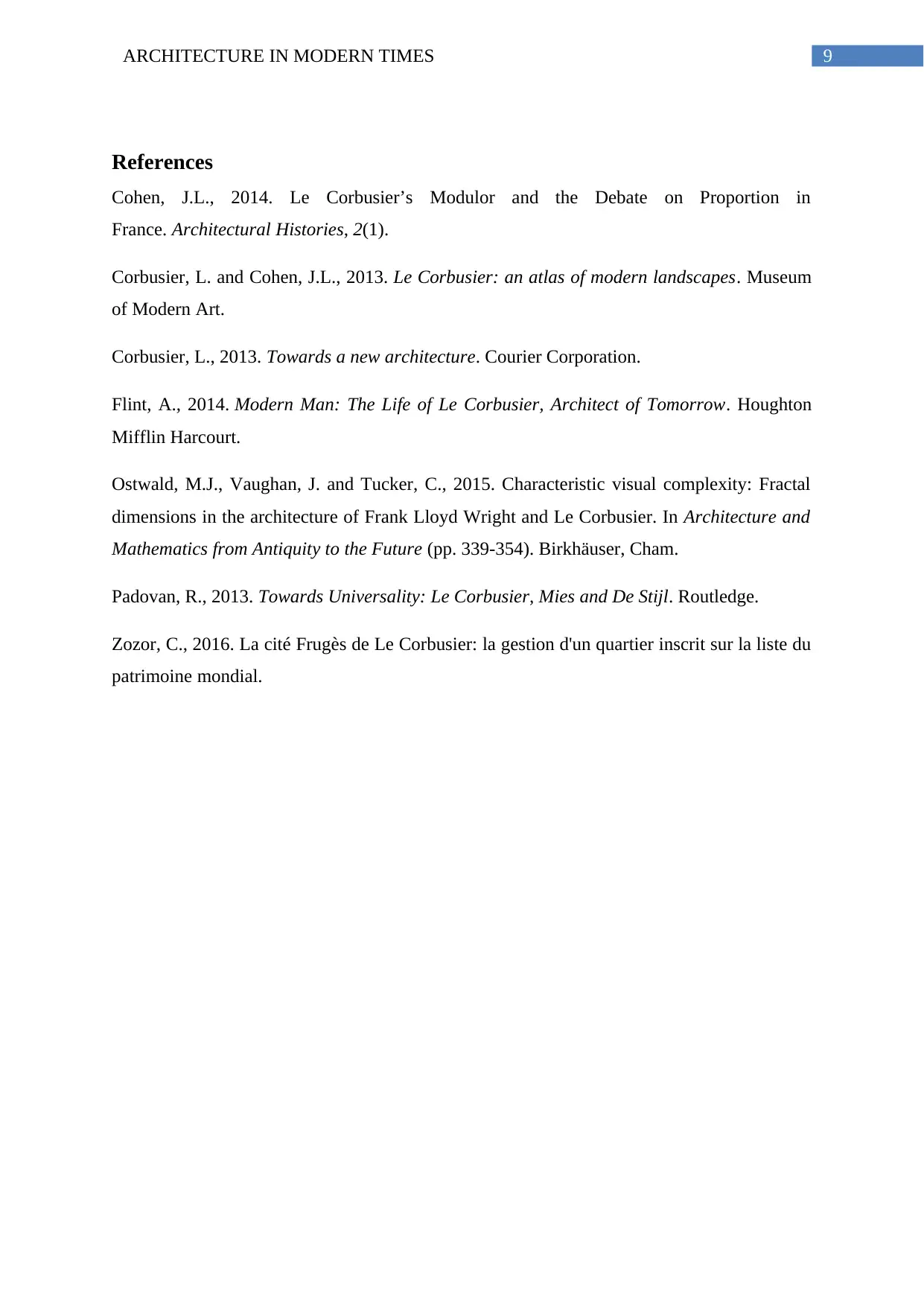
9ARCHITECTURE IN MODERN TIMES
References
Cohen, J.L., 2014. Le Corbusier’s Modulor and the Debate on Proportion in
France. Architectural Histories, 2(1).
Corbusier, L. and Cohen, J.L., 2013. Le Corbusier: an atlas of modern landscapes. Museum
of Modern Art.
Corbusier, L., 2013. Towards a new architecture. Courier Corporation.
Flint, A., 2014. Modern Man: The Life of Le Corbusier, Architect of Tomorrow. Houghton
Mifflin Harcourt.
Ostwald, M.J., Vaughan, J. and Tucker, C., 2015. Characteristic visual complexity: Fractal
dimensions in the architecture of Frank Lloyd Wright and Le Corbusier. In Architecture and
Mathematics from Antiquity to the Future (pp. 339-354). Birkhäuser, Cham.
Padovan, R., 2013. Towards Universality: Le Corbusier, Mies and De Stijl. Routledge.
Zozor, C., 2016. La cité Frugès de Le Corbusier: la gestion d'un quartier inscrit sur la liste du
patrimoine mondial.
References
Cohen, J.L., 2014. Le Corbusier’s Modulor and the Debate on Proportion in
France. Architectural Histories, 2(1).
Corbusier, L. and Cohen, J.L., 2013. Le Corbusier: an atlas of modern landscapes. Museum
of Modern Art.
Corbusier, L., 2013. Towards a new architecture. Courier Corporation.
Flint, A., 2014. Modern Man: The Life of Le Corbusier, Architect of Tomorrow. Houghton
Mifflin Harcourt.
Ostwald, M.J., Vaughan, J. and Tucker, C., 2015. Characteristic visual complexity: Fractal
dimensions in the architecture of Frank Lloyd Wright and Le Corbusier. In Architecture and
Mathematics from Antiquity to the Future (pp. 339-354). Birkhäuser, Cham.
Padovan, R., 2013. Towards Universality: Le Corbusier, Mies and De Stijl. Routledge.
Zozor, C., 2016. La cité Frugès de Le Corbusier: la gestion d'un quartier inscrit sur la liste du
patrimoine mondial.
1 out of 10
Related Documents
Your All-in-One AI-Powered Toolkit for Academic Success.
+13062052269
info@desklib.com
Available 24*7 on WhatsApp / Email
![[object Object]](/_next/static/media/star-bottom.7253800d.svg)
Unlock your academic potential
Copyright © 2020–2025 A2Z Services. All Rights Reserved. Developed and managed by ZUCOL.





